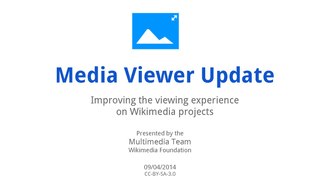閱讀/媒體/媒體查看器

This is the project hub for Media Viewer, a new tool developed by Wikimedia Foundation's multimedia team. For a quick overview of this project, visit 'About Media Viewer'.
媒体查看器计划改进读者和非正式编辑者的图片查看体验。
这个新的媒体查看器可以以更大的尺寸显示图片,并同时显示其内容、作者和元数据等有用的信息。它也提供了扩大、分享、下载或使用媒体文件的功能,如下所述。
Media Viewer was tested extensively during development, through usability studies, community consultations and online surveys. Based on this user feedback, the multimedia team developed a set of new improvements, to make Media Viewer easier to use by readers and casual editors, the primary target users for this tool.
Lessons learned from the development and from observing Media Viewer in production are available in the form of a retrospective and a research report.
在此帮助页面了解更多有关媒体查看器的内容。欢迎在此讨论页面提供反馈。
目标


目的
媒体查看器致力于:
- improve the viewing experience for readers and casual editors
- make it easier to preview and browse images
- provide a quick summary, with easy access to details
- offer more features such as enlarge, download, share and embed
These features are expected to encourage casual users to contribute more to Wikipedia and Wikimedia sister projects over time.
用户
媒体查看器的首要用户:
- 读者
- 临时编辑者
其他用户包括:
- 老练编者
- 贡献者
用户故事
We aim to support all these user groups, with an initial focus on readers in our first release. See user stories below for each user group.
读者故事
作为一个读者,我希望:
- view larger images
- find basic information
- browse related images
- share a link to this file
- use a simple, uncluttered interface
- view images on the same page (not another site)
- get back to the article easily
临时编辑者故事
作为一个贡献者,我希望:
- find more information
- see original images
- use this file in an article
- download this file
- view license terms
- view/edit file page details
老练编辑者故事
作为一位老练的编辑者,我希望:
- 检查元数据
- 查看许可条款
- 下载此文件
- 复制署名
- 查看所有文件详情
- 编辑文件信息
贡献者故事
作为一个贡献者,我希望:
- view my contributions
- get attributions if I'm the author or source
- find more details, such as where this file is used
- add or correct information on the file page
See also this multimedia vision for examples of how Media Viewer could be used by different user groups in coming years.
问题
User research suggests that the current file page brings up many issues for readers:
- too much information
- cluttered visual layout
- emphasizes text over images
- goes to a separate page (on other site, e.g. Commons)
- or goes to a duplicate page (on same site, e.g. Enwiki)
- longer load times
While this file page design works for advanced users, it is often confusing for casual users.
解决方案
Media Viewer offers a practical solution for readers, by making it easier to:
- preview larger images
- enlarge images
- browse related files
- read image captions
- see a short summary
- do all this over the same page you're on
Readers can also get more details on the file page, with a prominent button that provides quick access to all the metadata.
Experienced users can easily bypass or disable Media Viewer, if they prefer to go straight to the file page.
媒体查看器是怎样工作的?

To open an image in Media Viewer, click on its thumbnail on any article, gallery or category page. This will display a larger image in Media Viewer, right over the page where you clicked. We call this the 'lightbox view'.
图片
The image is shown in large size against a black background, as an overlay that fills up the entire browser page where you clicked on the thumbnail. This makes the image stand out more and removes some of the visual clutter typically found on a text-heavy page.
工具
These tools are provided to the side of the image:
- Close button (goes back to article view)
- Full screen button (expands into full-screen view, see below)
- Disable / Enable button
- Next and Previous buttons
- Download button
- Share / embed button
- Enlarge function (click on any image to go to its full-resolution file)
- 'More details' button (goes to the File: page)
The 'full-screen view' shows the large image across the entire screen (not just the browser window), with minimal information and buttons available on hover. This view lets you focus exclusively on the image, with no other distractions. In this mode, you only see the controls, the file name and the author/source/license if you hover over the image.
The Disable/Enable, Download and Share/Embed buttons open up small panels over the image. The Enlarge and 'More details' functions go to a separate page.
主要信息
Here is the most important information that is shown prominently, right below the image:
- Image caption or description (Golden-crowned Sparrow)
- Author (e.g. Alejandro Erickson)
- Source (e.g. Bird Institute)
- License Info (e.g. CC BY-SA 2.0)
次要信息
Here is the information that is shown below the fold, once you open the metadata panel (by scrolling down or pressing up/down arrow keys):
- Description (if not already shown)
- Uploader name (e.g. Smallbones)
- Creation or Upload Date (e.g. 12 April, 2012)
- Location (e.g. geo-tags, if any)
- License details (e.g. special credits or restrictions)
- More meta-data can be added to this panel, as needed (e.g.: file name).
These features are available every time you click on a thumbnail to open Media Viewer, as long as the tool is enabled. Media Viewer is now enabled by default on all Wikimedia sites, but can be disabled by any user, as described here. From a file description page, click on "Open in Media Viewer" below the image to view it with this tool.
想了解更多,请阅读此帮助文件。
新的改进
The Wikimedia Foundation's multimedia team developed a range of new improvements, based on community feedback and usability research.
Here are some of the key improvements that were released in November:
Here are screenshots showing what some of these improvements look like:
How you can help
If you find a technical issue with Media Viewer, please file a bug here on Phabricator.
You can also post your report on this discussion page, with a screenshot and information on your browser and operating system :).
Before reporting a bug, check first that this issue is not already on this list of known bugs. In case it’s already been fixed, you may also want to test it on this test page on MediaWiki.org -- where new features are released a week before the rest of the wikis.
Work in progress can usually be tested on this beta site, where new features are rolled out before going to production.
Note: Media Viewer only supports the most widely used image file formats on Wikimedia sites (e.g.: JPEG, GIF, PNG, TIFF, SVG). In future releases, we plan to add support for more file formats, such as PDF, audio and video files.
Development
Media Viewer was developed by the Wikimedia Foundation's multimedia team from July 2013 to November 2014. It was designed in collaboration with community members, in a series of discussions held over video conferences, IRC, and face-to-face meetings. This tool was then developed and tested as a Beta Feature through April 2014, when it was gradually released worldwide, over a three-month period.
Based on user feedback, a wide range of improvements were developed to make Media Viewer easier to use, such as: an easier way to enlarge images, image captions, a prominent link to the File: page and an easier way to disable the tool for personal use.
Feature development has now ended for this project.
Feedback
Media Viewer was tested extensively with millions of readers and casual editors, the primary target users for this tool.
User feedback was collected through a variety of methods:
Please check the links above for more information about these different sources of user feedback.
Over 18,199 feedback responses about Media Viewer were collected as part of a wide online survey hosted in multiple languages, from April to July 2014. A majority of global respondents found the tool "useful for viewing images and learning about them" (56% "useful", 35% "not useful", 9% "not sure"), based on total unweighted survey results, as shown on this spreadsheet. When weighted to match global Wikipedia readership for each language, fewer respondents found the tool "useful" than "not useful" (39% "useful", 50% "not useful", and 10% "not sure"). Cumulative "useful" approval ratings by language: English 36%, French 70%, Spanish 78%, Dutch 59%, Portuguese 81%, German 30%, Hungarian 63%, Catalan 71%. Readers tended to view the tool more favorably than advanced users. These approval ratings increased over time in all languages, suggesting that users found Media Viewer more useful for viewing images over time, as new improvements were developed based on feedback. Note that this was an optional survey, so approval rates should not be cited as a conclusive metric, as they are subject to self-selection bias (just like RfCs cited below).
Five requests for comments (RfCs) about Media Viewer were initiated by community members in the summer of 2014: two on the English Wikipedia, two on the German Wikipedia, and one on Wikimedia Commons. These RfCs typically involved up to a couple hundred contributors at a time, with low participation from readers, the target users for this product. Feedback from these RfCs shows that a majority of participants (including every single "reader" and "casual editor") believed that the "Media Viewer" should be disabled by default for all users, logged-in or not, and either left as an opt-in feature or scrapped altogether. Aside from any technical shortcomings, discontent was also shown with the manner in which the project was conducted and the lack of transparency shown by the team responsible.
Code
The code for Media Viewer is made possible by two separate extensions:
- Multimedia Viewer Extension – the front-end extension that displays media files and information
- Commons Meta Data – the back-end API that serves information to the Media Viewer
将来版本
Feature development has now ended for this version of Media Viewer. In future versions, the multimedia team will consider adding more features requested by our community, such as a better zoom tool, a Mobile Media Viewer and/or support for more file formats (e.g. slides, video, audio, as shown in these slides).
Here are some features that may be considered for future versions:
- Zoom on this file
- Show file collection panel
- View files in slideshow mode
- Show PDF slides
- Play Video files
- Play Audio files
- Support Developer Plugins
- Mobile Media Viewer
Future versions could also include feedback tools below the image (e.g. thank, flag), as suggested by this 2016 multimedia vision, as well as best practices from other media sites. For an overview of other features that could be considered for these future versions, check the annual multimedia plan for 2014–15.
Thanks
Many thanks to all the community and team members who contributed to this project. Special acknowledgements to the project team: Fabrice Florin, Gilles Dubuc, Mark Holmquist, Gergő Tisza, Pau Giner, Keegan Peterzell, Rob Lanphier, Howie Fung and Erik Moeller, to name but a few.
To learn more about other multimedia projects, visit this Multimedia project hub.




